In this article I will discuss the most common causes of Candida overgrowth. Find out whether you’re being exposed to one or more of the yeast infection triggers listed below.
Let me remind you that this is a sub-article to my Guide to Candida Overgrowth: Symptoms, Causes, Testing and Treatment that bases on the following books and resources:
- The Candida Crusher, a very thorough 700-page book by naturopath Eric Bakker from New Zealand. He has successfully treated thousands of patients over the past 25 years and I found great value from his book.
- Yeast Infection No More BOOK by Linda Allen. Yeast Infection No More is also available in Spanish, Italian, Portuguese, and German.
- The Candida Summit 2018 held by Evan Brand, BCHN, CFMP, NTP including 33 expert interviews.
Download my FREE EBOOK on Candida Overgrowth for a complete guide!
Yeast infection is a complex condition triggered by more than one factor, which is what makes it very difficult to get under control.
The basic most fundamental truth regarding the vast majority of chronic health conditions, including Candida yeast infection, is that there is no such thing as a single cause.

Mycozil is a unique, all-natural formula designed specifically to support the body’s natural balance of yeast and fungal organisms. It’s made with potent herbs and enzymes that work with your body’s internal defenses to protect against the spread of harmful organisms.
Disclosure: this post contains affiliate links. As an Amazon Associate and Global Healing affiliate I earn from qualifying purchases. For every purchase made from the links in this post, you’ll be able to support my work. So you can look after your health, and contribute to my mission at the same time. Thank you!
Here are 16 most common yeast infection causes:
1. Antibiotics
Antibiotics are used to kill disease-causing bacteria, but unfortunately they also kill normal, protective bacterial flora throughout your body and actually encourage yeast infections.
2. Antibiotics in meat
Many different kinds of antibiotics are also found in commercial poultry, pork, beef and other meats.
3. Immune system deficiency
An underlying inherited or acquired immune system deficiency. Be sure to have the appropriate blood tests to uncover any potential causes like neutropenia, which means poor levels of neutrophils or white blood cells (get a full blood count), vitamin B12 or folate deficiencies.
4. Steroids and other drugs
For example, contraceptive pills, heartburn or anti-ulcer preparations.
5. Alcohol
Especially beer, white wine and spirits like whisky, rum and bourbon. If you’re determined to heal yourself from Candida overgrowth, you need to say goodbye to alcoholic beverages.
6. Candida friendly foods
Sugar, refined grains, dairy, vinegar, alcohol, mouldy foods (soft cheeses), too much sweet fruits (especially dried fruit) etc. More on foods in my post Vegan Candida Diet. To help people get on track with foods to eat, recipes to make, supplements and healthy eating habits, I’ve created Candida diet meal plans.
7. Stress
Stress will eventually deplete our body’s ability (adrenal glands) to produce sufficient cortisol that in turn reduces the immune system’s functionality. Fluctuating cortisol levels also cause blood-sugar dysregulation (hypoglycemia) that is a further risk factor for candida.
8. Inappropriate clothing, bad hygiene
Wearing tight clothes or synthetic fabrics will disallow the vagina or penis area to breathe and make the area over-acidic, thus accelerating the yeast overgrowth process. Using famous brands of feminine hygiene products can also change the pH level of the vaginal environment, allowing the overgrowth of yeast infection in that area. Walking, sitting or just staying inside wet clothing such as a bathing suit or underwear can contribute to excess moisture in the penis or vaginal area, triggering yeast infection.
9. Sexual activity
Yeast infection, especially in the vaginal or penis area, can be contagious and is more so during sexual activity. Practicing caution and treating your partner’s yeast infection prior to having sexual intercourse is an important step to preventing the spread of yeast infection.
10. Exposure to pesticides, herbicides, chemicals, toxic metals
Try to buy as much organic food as possible or grow your own. At least follow the dirty dozen and clean fifteen by Environmental Working Group. It is equally important not to use harmful chemicals on yourself or to clean your home. Think of cosmetics (lotions, nail polish, creams, mascara, eye shadows, powders), haircare (shampoo, conditioner, foam, spray), detergents (laundry, dishes), hand soap, and other cleaning agents. Make a big clean-up and replace the items that are harmful and disrupt your endocrine system. Finally, you also might be exposed to toxic metals such as lead and mercury. Hair or urine testing may reveal a heavy metal problem.
11. Improper acid-alkaline balance
For the human body to function at its best, it has to have an internal chemistry balance of alkaline with a pH of 7.0-8.0. A diseased cell has an alkaline of below 7.0. It’s our responsibility to provide the body with alkaline from outside sources, mainly from food. When we consume acidic foods, the body must neutralise them with alkaline. If it cannot find any alkaline, the body uses the alkaline in the cells to do the job, and when these cells become acidic, they develop diseases. A state of over-acidity causes the blood to become sludgy and thick, creating the ideal environment for Candida growth.
In order to maintain a healthy balanced body and prevent over-acidity and toxicity that lead to Candida overgrowth, you must consume lots of alkaline-forming foods while minimising acidic foods.
Stress and negative thoughts also cause an acid environment. So, stress management is vital for those with Candida overgrowth.
12. Hormonal imbalance
When there is an imbalance between estrogen and progesterone due to birth control pills or hormone replacement therapy or even before your menstrual period, it can interfere with the intestinal flora, thus allowing Candida yeast infection to take control and multiply. I suggest reading WomanCode: Perfect Your Cycle, Amplify Your Fertility, Supercharge Your Sex Drive, and Become a Power Source by Alisa Vitti. Alisa shows women how to maintain health and vitality with a food-based program to rebalance their hormones.
13. Weakened immune system
When our immune system is weakened due to several factors such as nutritional deficiency, high toxic buildup (heavy metals, chemicals, bacteria, viruses, parasites), stress, lack of sleep or the use of pharmaceutical drugs such as antibiotics and steroids, the body becomes vulnerable to virtually every type of sickness and disease. In this state the body cannot defend itself and cannot control the process of Candida overgrowth as it could if the immune system was at its peak performance.
14. Diabetes
Diabetics are more prone to candida yeast infections for several reasons, but the main connection is that diabetics have problems regulating their blood sugar levels and are prone to hormonal fluctuations. Balance your blood sugar and hormones with the help of Alisa Vitti. Or check out my Candida diet meal plans.
15. Chlorinated water
Chlorinated water is a big but commonly overlooked problem in the development of a yeast infection. By swimming in a chlorinated pool or a Jacuzzi (spa pool) you are allowing your body to absorb plenty of chlorine, an antibiotic.
16. Mould exposure
Make sure you don’t work or live in a mouldy environment. Get your home and workplace tested if necessary. Should you continue being exposed to mould on a daily basis, not any diet or the supplements will heal you from Candida overgrowth.
There are also life situations, external factors and psychological and mental factors that directly or indirectly form the environment in which Candida gets out of control and manifests itself in a variety of the common yeast infection symptoms.
Download my FREE EBOOK on Candida Overgrowth!
Already sure that you have Candida overgrowth or need regulating your blood sugar? Make sure to have a look at my Candida diet meal plans.
Disclaimer: this post contains affiliate links.
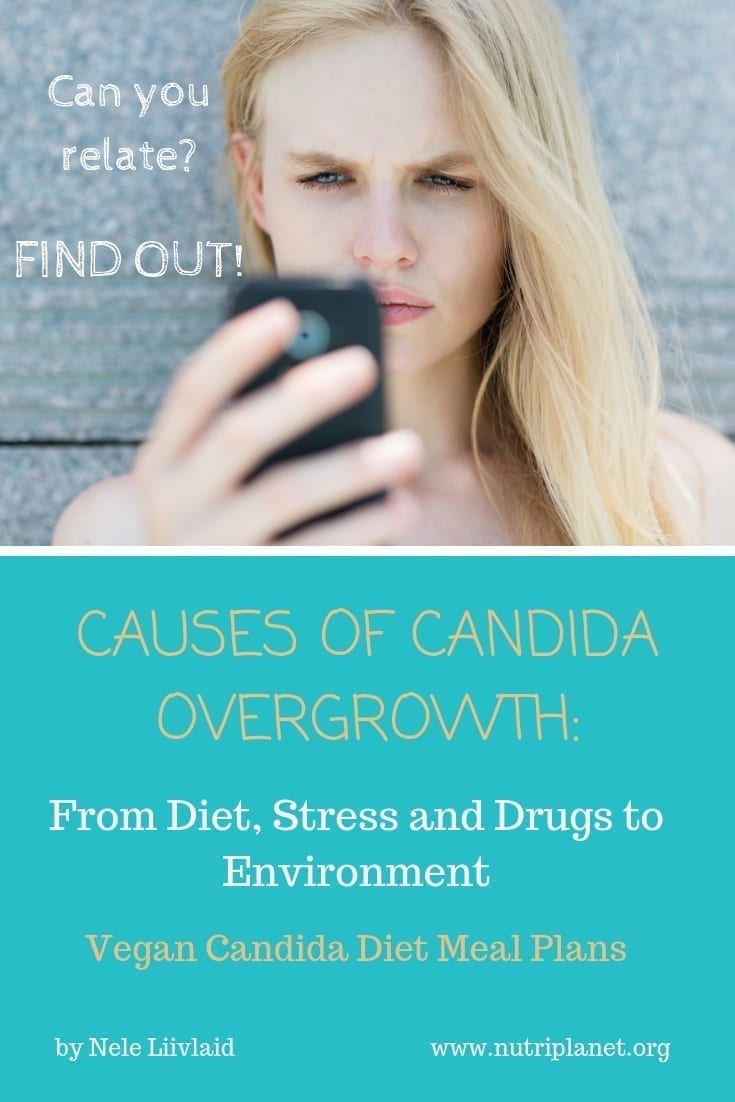



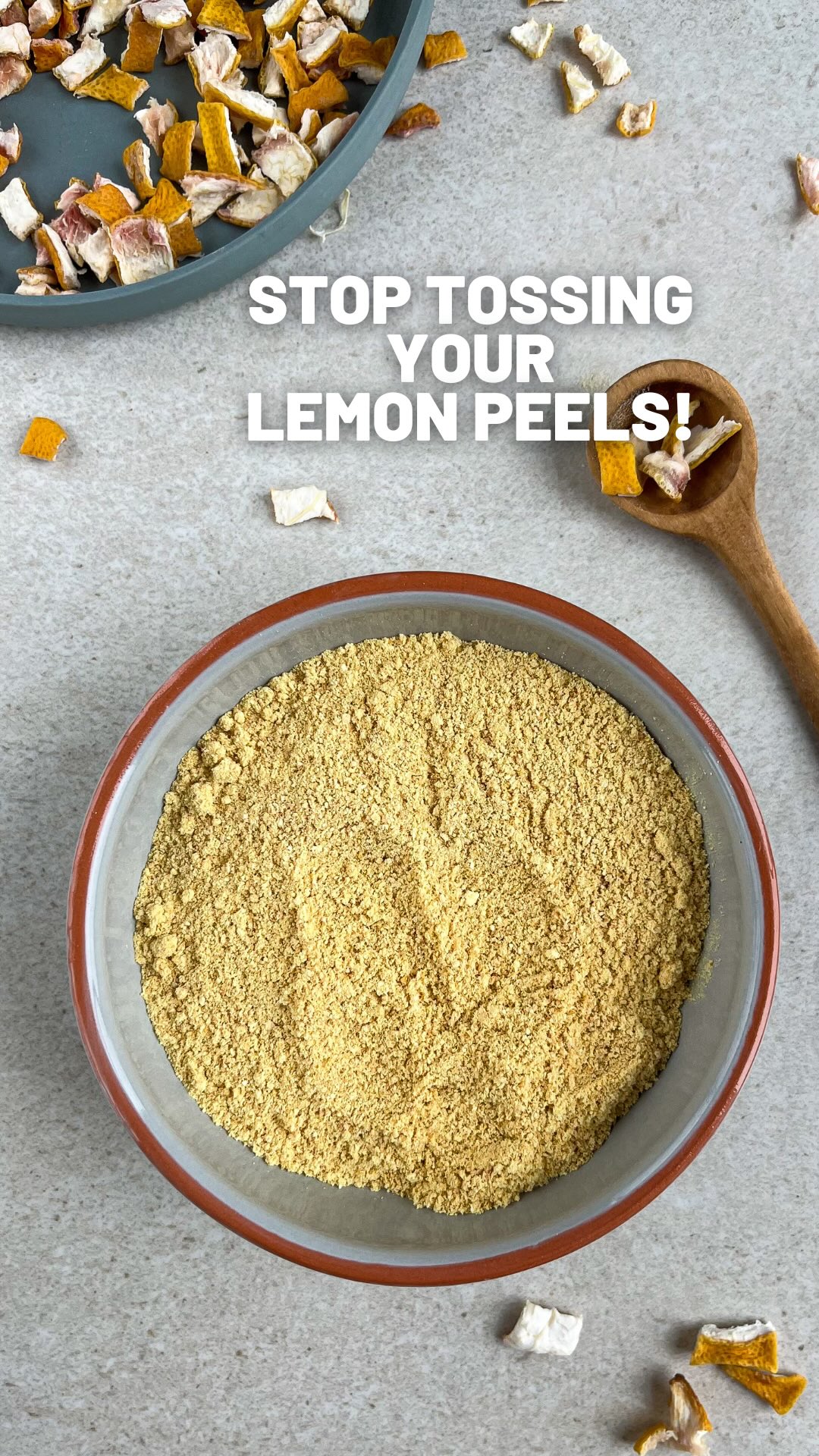
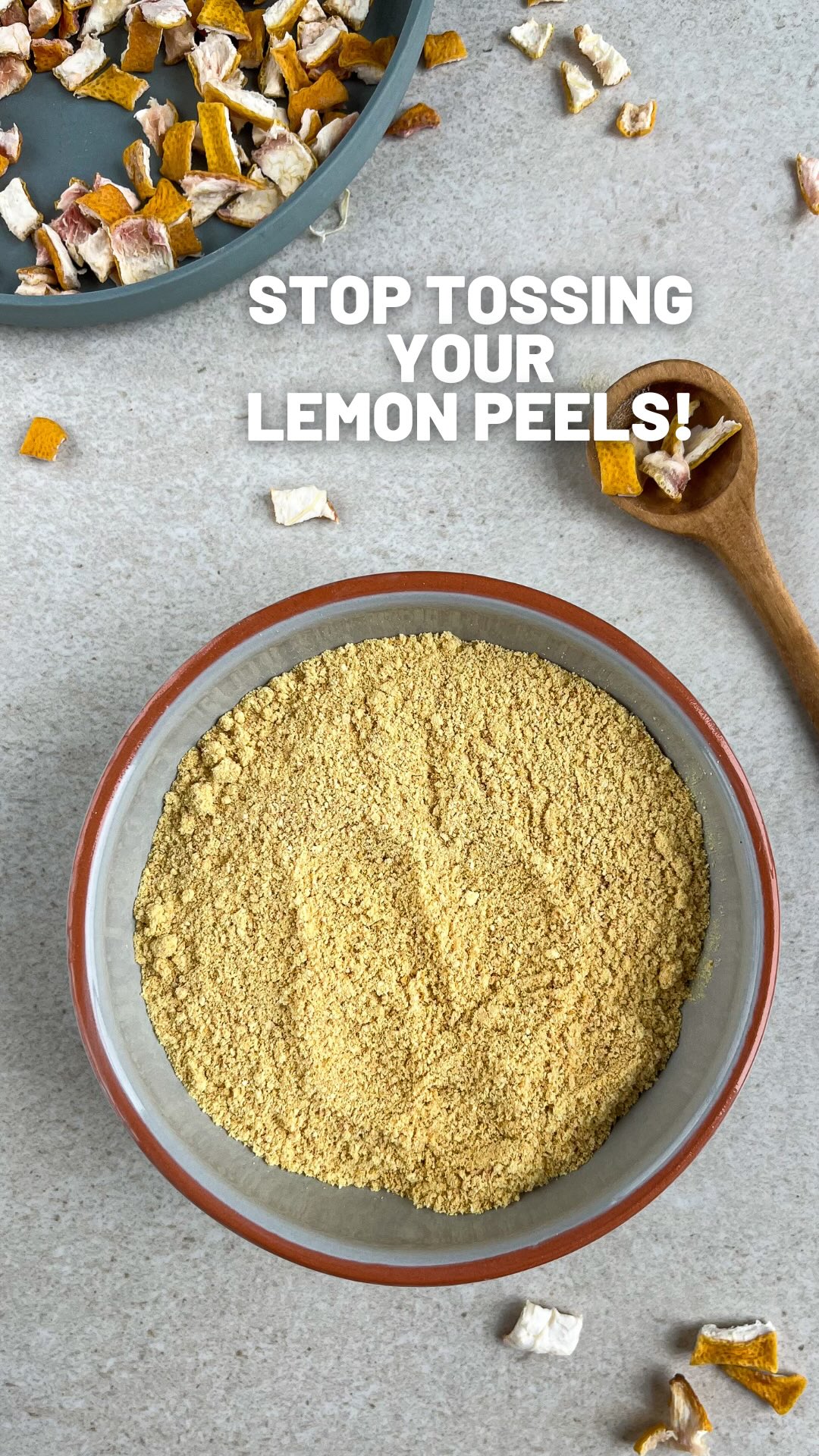

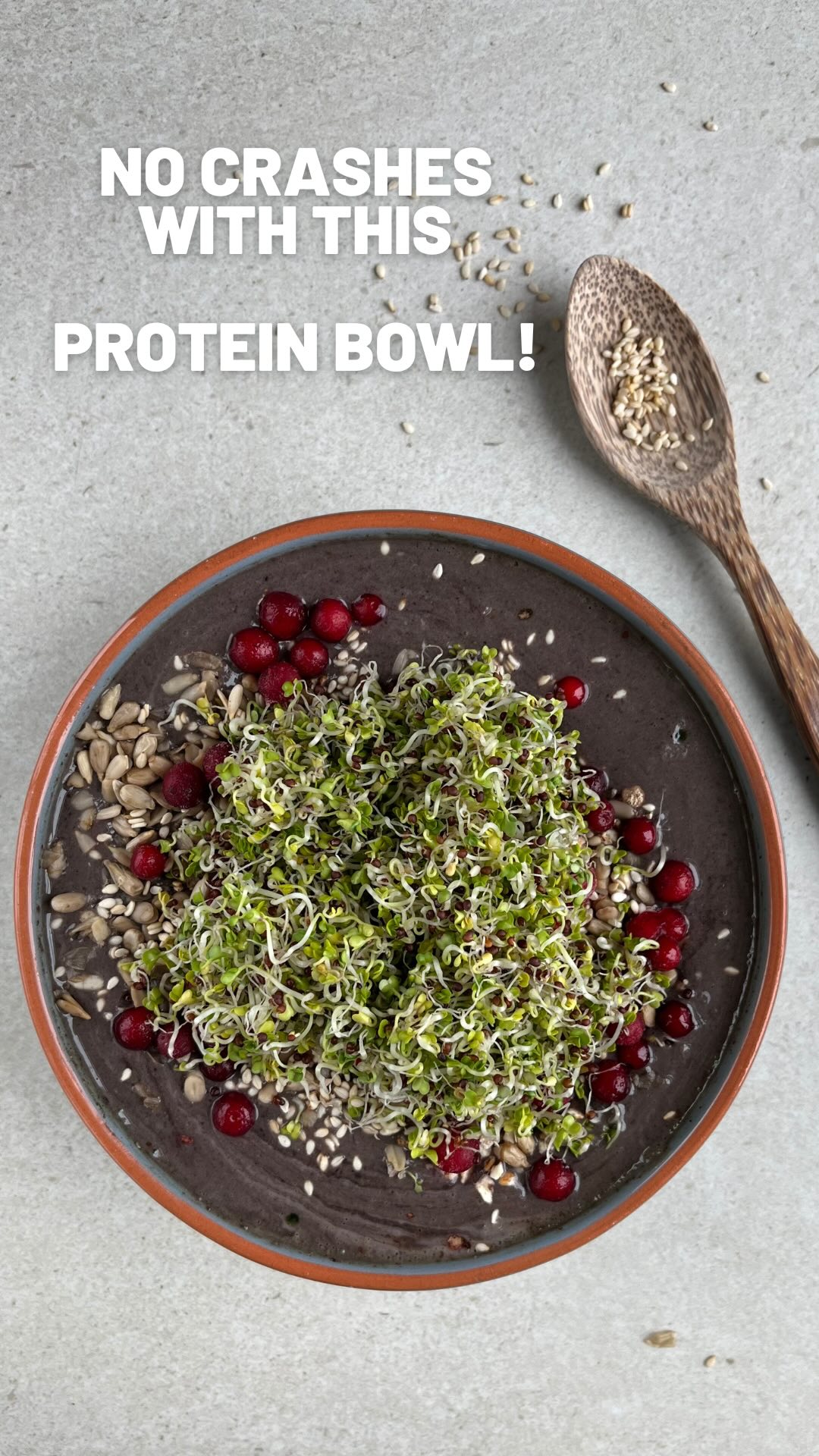











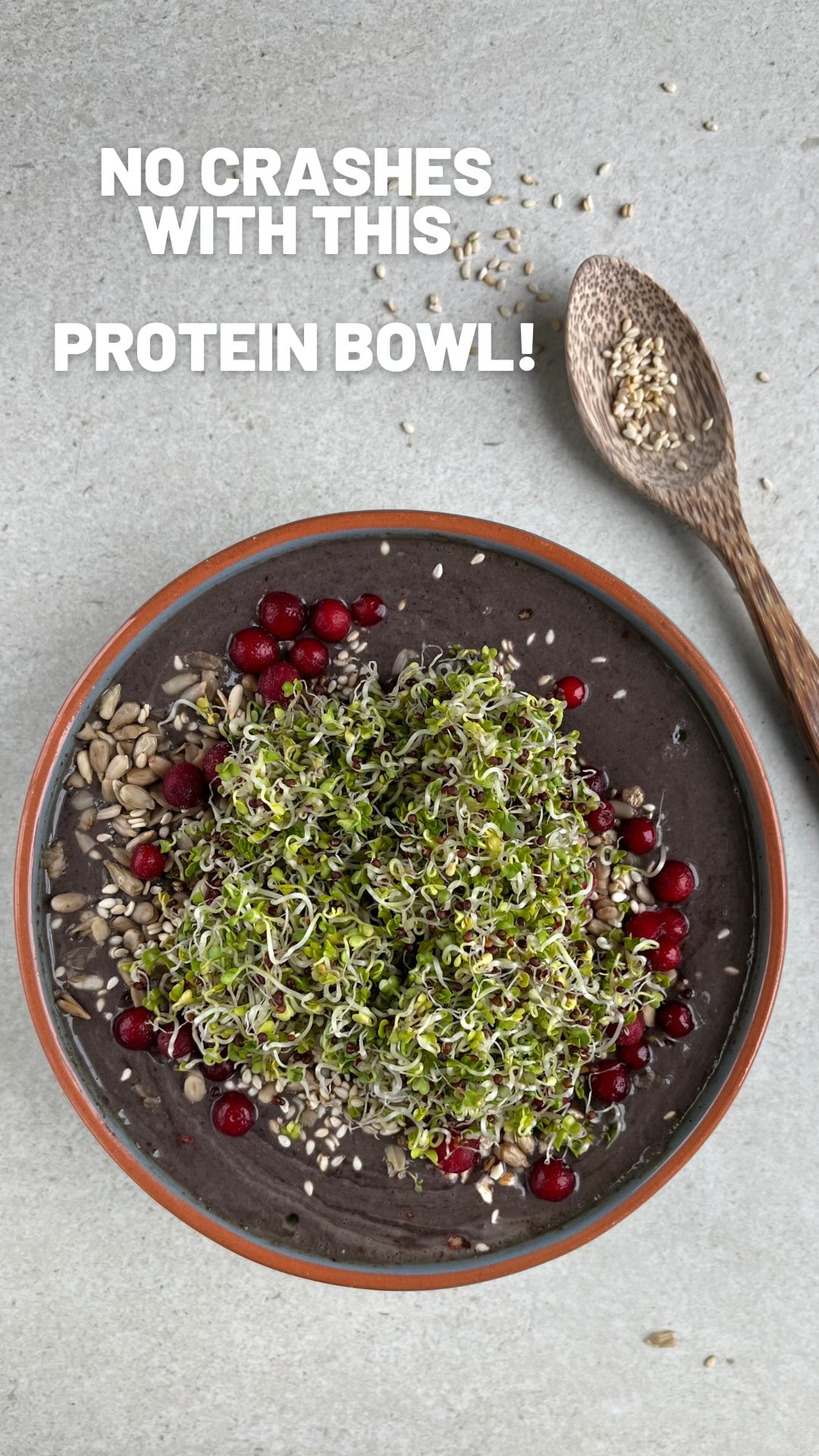






















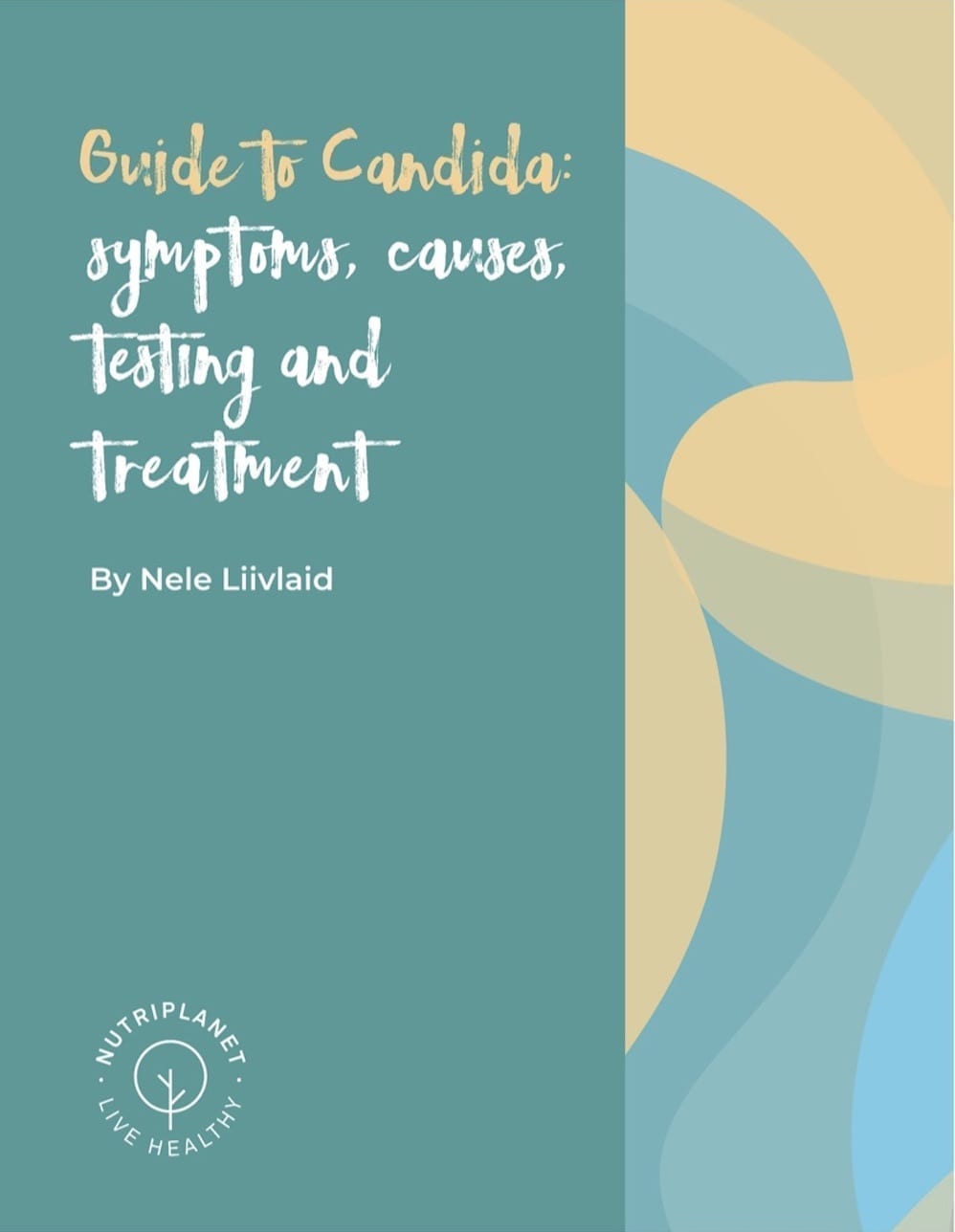
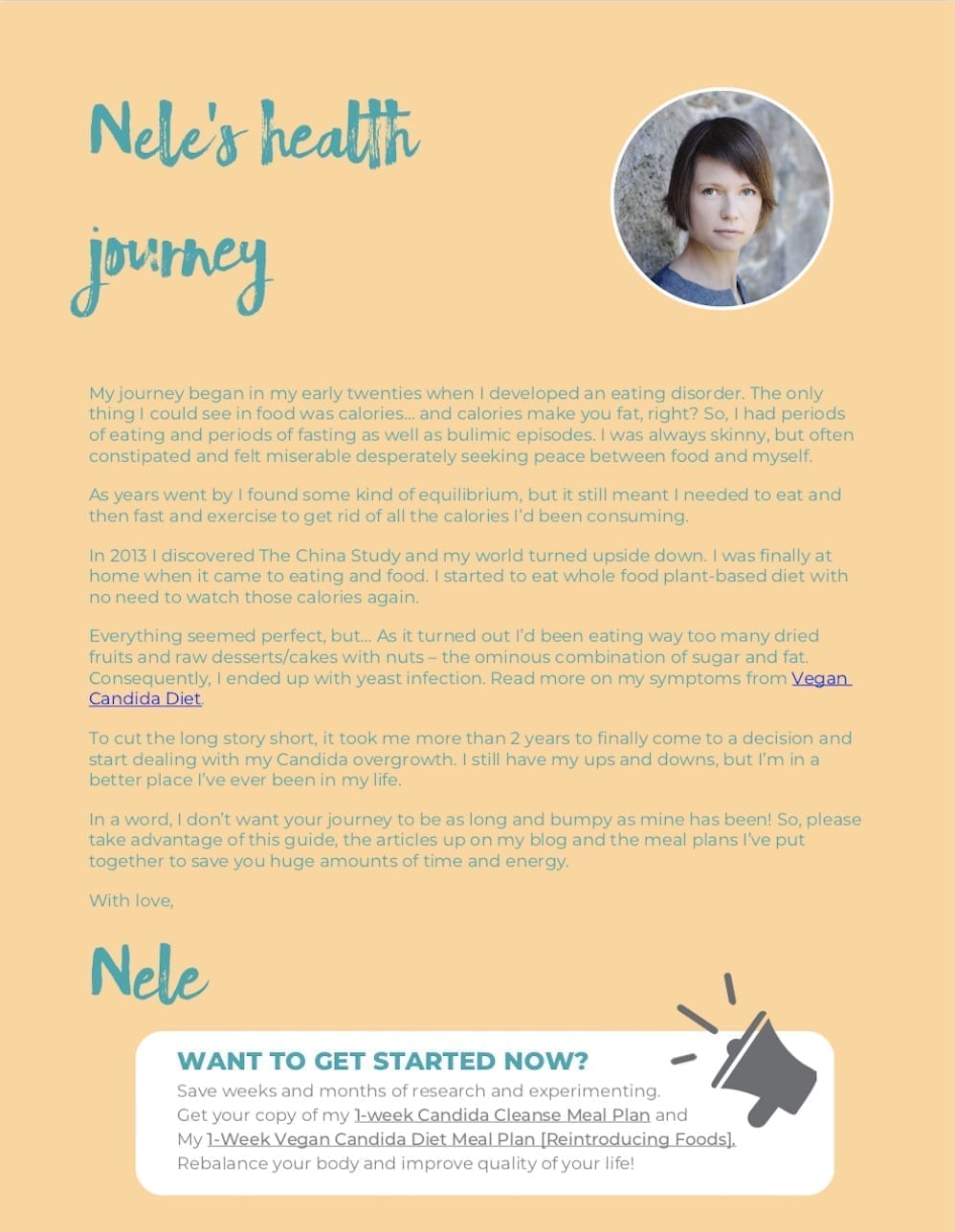
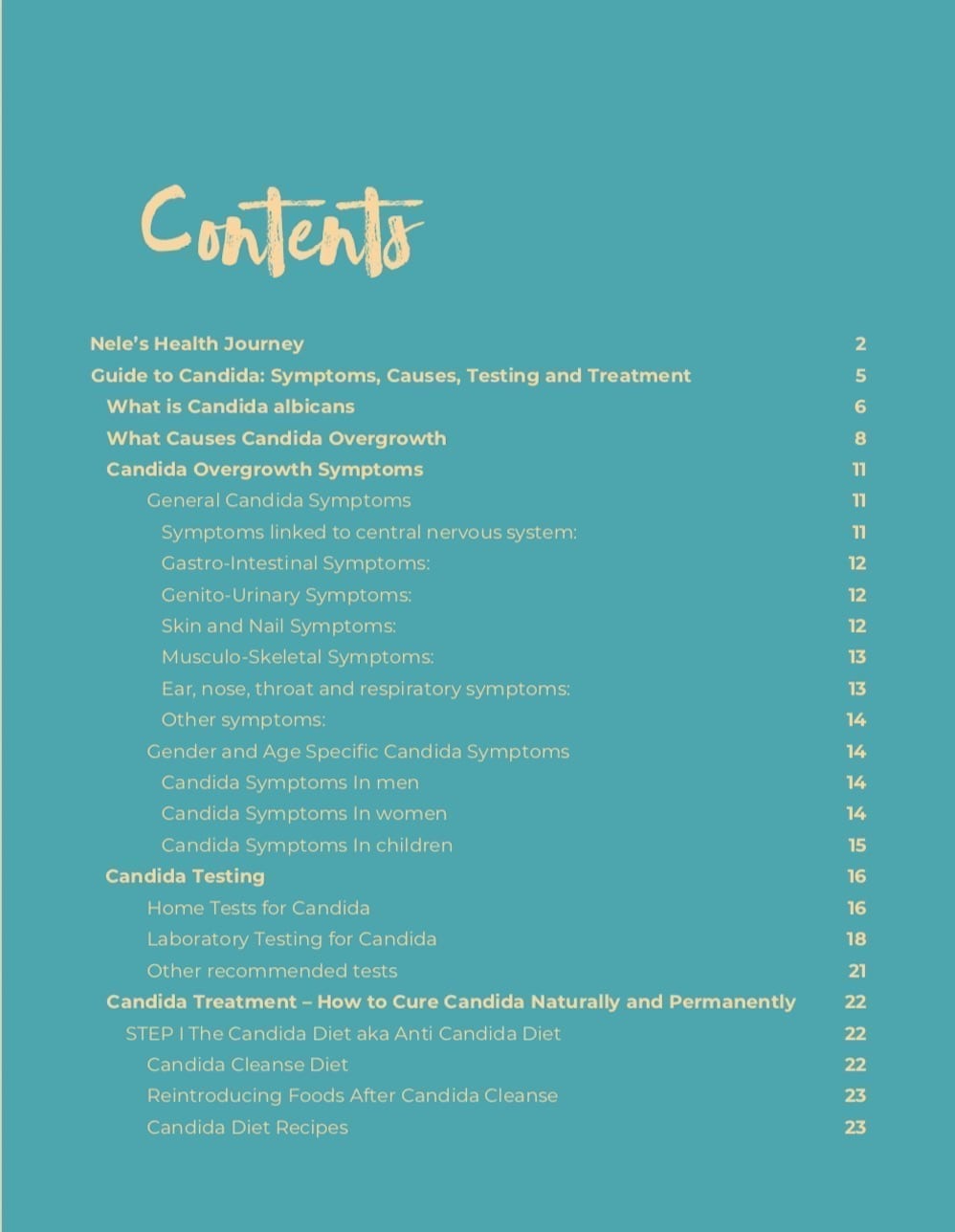
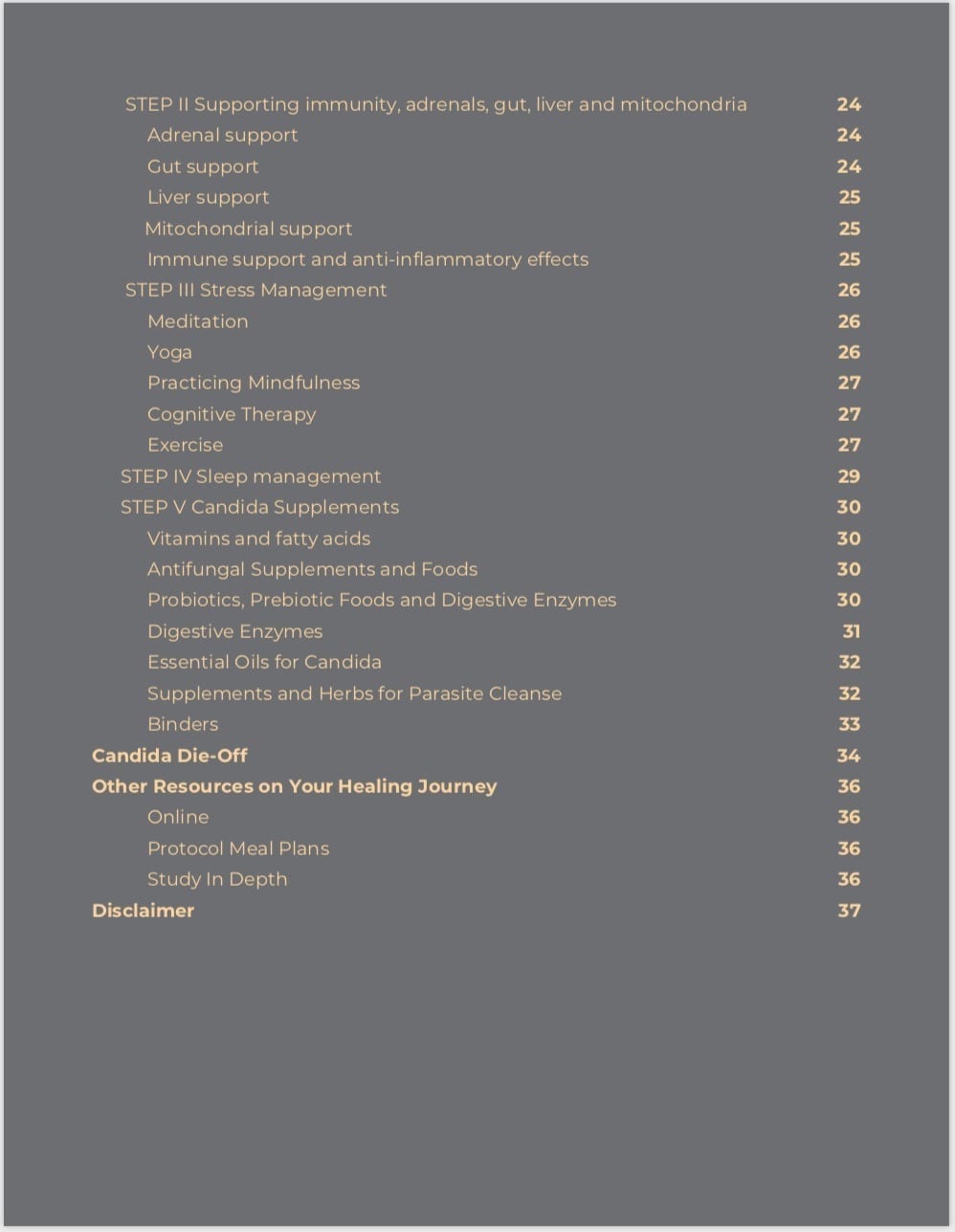
What would you recommend for candida overgrowth on skin and scalp? I’ve been taking anti fungal supplements, but I can’t get rid of spots on skin and very shiny and itchy scalp.
Thank you!
Hi Katrina,
I’d recommend visiting a naturopath or functional medicine doctor to get you tested and determine whether your problems are indeed caused by Candida overgrowth. If they are, you’d need to go through Candida cleanse and change your lifestyle to keep yourself in balance.
All the best!
Thank you so much for your response Nele! My naturopath did the blood test and said the spots are caused by fungal overgrowth after taking antibiotics. She put me on anti fungal diet and supplements, but topically she only recommends using ACV and coconut oil. I don’t see much improvement with these. I thought maybe there are other things I could try.
Thanks so much again!
Hi again!
I’m sure you know that improvement comes from inside — once you start to heal, also the visible symptoms will disappear. The symptoms you’ve had the longest, will most probably be the last to go away. One thing you could try is tea tree oil though.
Medical Disclaimer
The information shared is not intended to replace a one-on-one relationship with a qualified health care professional and is not intended as medical advice. It is intended as a sharing of my personal knowledge and experience as well as information from the research. I encourage you to make your own health care decisions based upon your research and in partnership with a qualified health care professional.